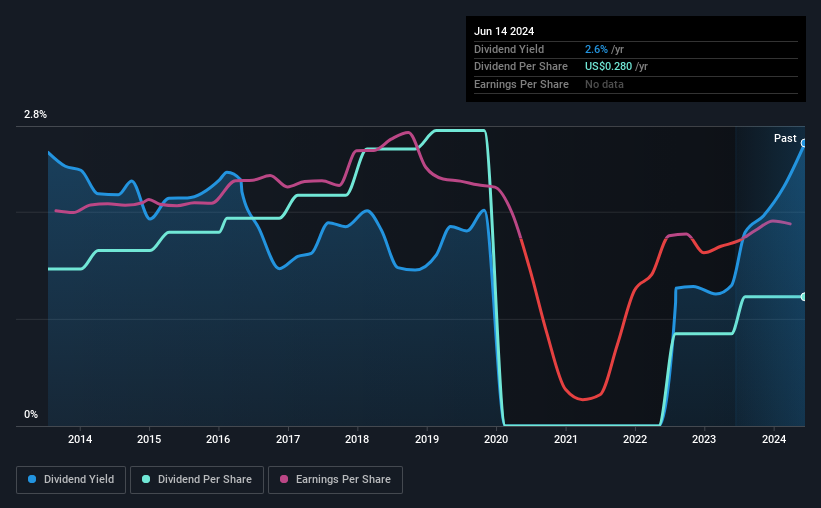Just One Day Till The Marcus Corporation (NYSE:MCS) Will Be Trading Ex-Dividend
Regular readers will know that we love our dividends at Simply Wall St, which is why it's exciting to see The Marcus Corporation (NYSE:MCS) is about to trade ex-dividend in the next day or two. Typically, the ex-dividend date is one business day before the record date which is the date on which a company determines the shareholders eligible to receive a dividend. The ex-dividend date is an important date to be aware of as any purchase of the stock made on or after this date might mean a late settlement that doesn't show on the record date. Thus, you can purchase Marcus' shares before the 17th of June in order to receive the dividend, which the company will pay on the 26th of June.
The company's upcoming dividend is US$0.07 a share, following on from the last 12 months, when the company distributed a total of US$0.28 per share to shareholders. Calculating the last year's worth of payments shows that Marcus has a trailing yield of 2.6% on the current share price of US$10.60. If you buy this business for its dividend, you should have an idea of whether Marcus's dividend is reliable and sustainable. As a result, readers should always check whether Marcus has been able to grow its dividends, or if the dividend might be cut.
View our latest analysis for Marcus
Dividends are typically paid out of company income, so if a company pays out more than it earned, its dividend is usually at a higher risk of being cut. Marcus is paying out an acceptable 67% of its profit, a common payout level among most companies. A useful secondary check can be to evaluate whether Marcus generated enough free cash flow to afford its dividend. What's good is that dividends were well covered by free cash flow, with the company paying out 16% of its cash flow last year.
It's encouraging to see that the dividend is covered by both profit and cash flow. This generally suggests the dividend is sustainable, as long as earnings don't drop precipitously.
Click here to see the company's payout ratio, plus analyst estimates of its future dividends.
Have Earnings And Dividends Been Growing?
Businesses with shrinking earnings are tricky from a dividend perspective. If earnings decline and the company is forced to cut its dividend, investors could watch the value of their investment go up in smoke. Readers will understand then, why we're concerned to see Marcus's earnings per share have dropped 27% a year over the past five years. When earnings per share fall, the maximum amount of dividends that can be paid also falls.
Many investors will assess a company's dividend performance by evaluating how much the dividend payments have changed over time. Marcus has seen its dividend decline 1.9% per annum on average over the past 10 years, which is not great to see.
Final Takeaway
Has Marcus got what it takes to maintain its dividend payments? The payout ratios are within a reasonable range, implying the dividend may be sustainable. Declining earnings are a serious concern, however, and could pose a threat to the dividend in future. It might be worth researching if the company is reinvesting in growth projects that could grow earnings and dividends in the future, but for now we're not all that optimistic on its dividend prospects.
If you're not too concerned about Marcus's ability to pay dividends, you should still be mindful of some of the other risks that this business faces. To help with this, we've discovered 1 warning sign for Marcus that you should be aware of before investing in their shares.
Generally, we wouldn't recommend just buying the first dividend stock you see. Here's a curated list of interesting stocks that are strong dividend payers.
Have feedback on this article? Concerned about the content? Get in touch with us directly. Alternatively, email editorial-team (at) simplywallst.com.
This article by Simply Wall St is general in nature. We provide commentary based on historical data and analyst forecasts only using an unbiased methodology and our articles are not intended to be financial advice. It does not constitute a recommendation to buy or sell any stock, and does not take account of your objectives, or your financial situation. We aim to bring you long-term focused analysis driven by fundamental data. Note that our analysis may not factor in the latest price-sensitive company announcements or qualitative material. Simply Wall St has no position in any stocks mentioned.
Have feedback on this article? Concerned about the content? Get in touch with us directly. Alternatively, email editorial-team@simplywallst.com

 Yahoo Finance
Yahoo Finance 
